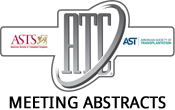2016 American Transplant Congress
Impact of Angiotensin II Type I Receptor Antibody Positivity in Highly-HLA Sensitized (HS) Patients Transplanted After Desensitization (DES).
Introduction: Angiotensin II type I receptor antibody (AT1R Ab) is a target for non-HLA antibodies. AT1R ab exert direct effects on endothelial and vascular smooth…2016 American Transplant Congress
Alloimmunity Through Non-HLA Epitopes in Kidney Transplantation.
Introduction: An unexpected diversity in the human genome has been identified including more than 2,500 nonsynonymous single nucleotide polymorphisms (nsSNP) and up to 20 homozygous…2016 American Transplant Congress
FGF and Wnt Signaling in Pancreatic Progenitor and Beta-Cell Growth.
Beta-cell replacement therapy offersa cure for diabetes, but this is limited by the lack of readilyavailable supply of cells. Our goal is generate enough beta-cells…2016 American Transplant Congress
Delaying the Induction of Mixed Chimerism Until Two Months After NHP Heart and Kidney Cotransplantation Results in Long Term Survival.
Background. We have previously achieved delayed tolerance in cynomologous recipients cotransplanted with heart and kidney allografts by treating recipients with standard triple drug immunosuppression for…2016 American Transplant Congress
MiRNA-200b Inhibits Epithelial-Mesenchymal Transition in TGF-β1 Induced Human Bronchial Epithelial Cells.
Institute of Cellular Medicine, Newcastle University, Newcastle Upon Tyne, United Kingdom.
The role of TGF-β1 in mediating extracellular matrix remodeling during the pathogenesis of lung fibrosis has been well defined. Dysregulated expression of miRNA is increasingly…2016 American Transplant Congress
Trends in Aspergillus Infection After Liver Transplantation, 1988-2014.
Background: Invasive Aspergillosis is an important cause of morbidity and mortality in liver transplant recipients. Aspergillus may account for up to 25% of all fungal…2016 American Transplant Congress
Early Enteral Feeding After Living Donor Liver Transplantation Prevents Infectious Complications: A Prospective Pilot Study.
Background: Infectious complications, including bacteria, virus, and fungus, often occur after liver transplantation and are the most frequent cause of in-hospital mortality. The present study…2016 American Transplant Congress
Kidney Transplants from Anuric Deceased Donors on Renal Replacement Therapy.
Transplantation, California Pacific Medical Center, San Francisco, CA.
Transplantation of deceased donor kidneys with Acute Kidney Injury (AKI) has become a generally well accepted practice with excellent results documented in the literature. The…2016 American Transplant Congress
Conversion to Belatacept as Rescue Therapy in Kidney Transplant Recipients with Severe Graft Dysfunction.
Belatacept is a fusion protein that prevents T cell co-stimulation via the CD28 receptor. If used as first-line therapy, immunosuppression with Belatacept is associated with…2016 American Transplant Congress
Pediatric Kidney Transplantation and Mortality: Distance to Transplant Center Matters.
Surgery, Massachusetts General Hospital, Boston, MA.
INTRODUCTION: The distance traveled by adults to kidney transplant centers contributes to disparities in access and outcomes. We hypothesized that distance would adversely affect the…
- « Previous Page
- 1
- …
- 118
- 119
- 120
- 121
- 122
- …
- 180
- Next Page »
